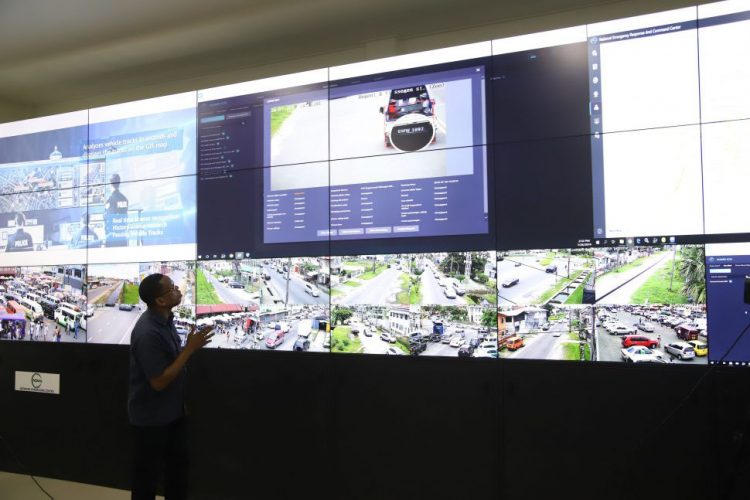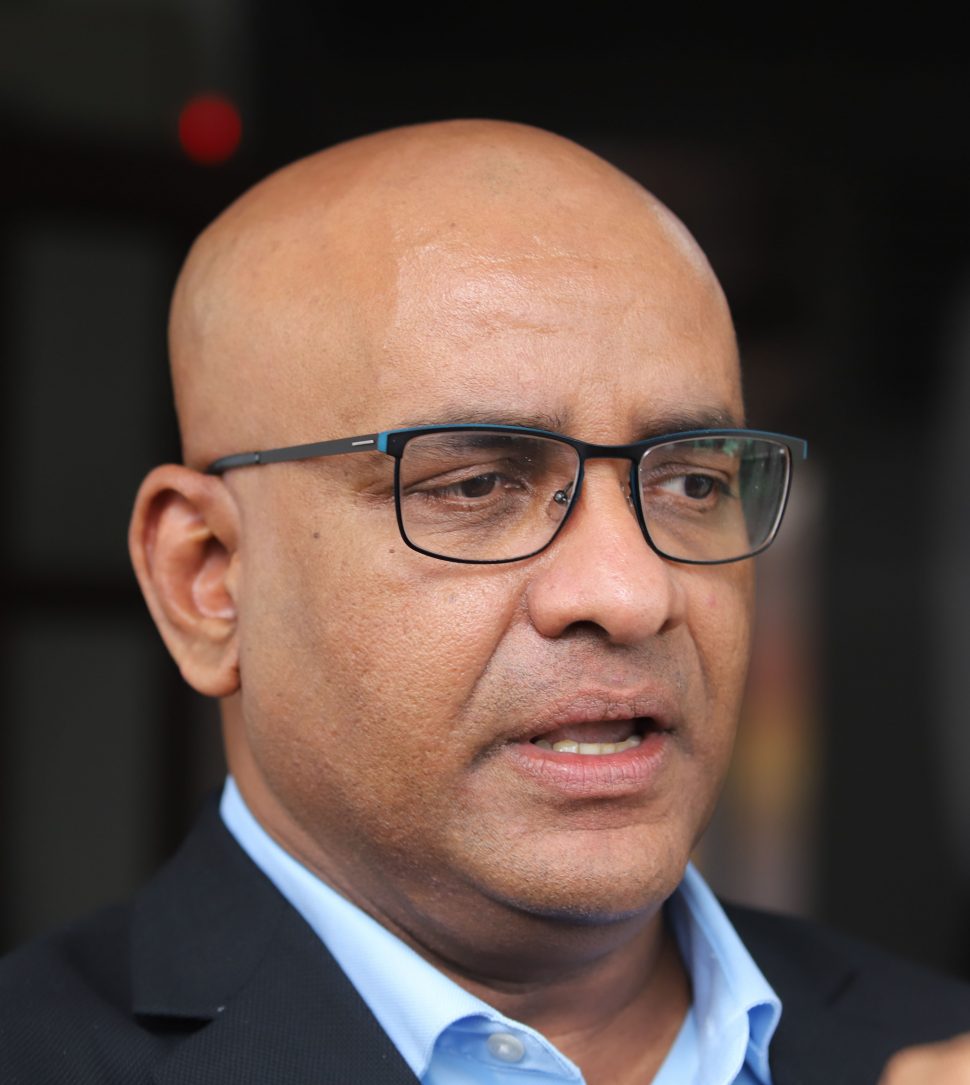Vice President, Bharrat Jagdeo on Thursday said that the government is working on a biometric project that will allow the authorities to use facial recognition software to track people with criminal records and pinpoint their exact location at any given time.
As such he said the new Brickdam Police Station which is being built will assist in bolstering the country’s security plan.
Use of facial recognition software globally has attracted grave concerns that it could result in a breach of privacy and be abused if in the control of unaccountable authorities.
The Guyana Police Force (GPF) and the Ministry of Home Affairs on Tuesday hosted a sod-turning ceremony for the commencement of construction of the new Brick-dam Police Station which is estimated to be completed in 30 months. The 12-storey structure will be constructed by R. Bassoo & Son’s Contracting Com-pany in partnership with Qingjian Guyana Group Company Inc (CNQC) for US$28,140,000.

A demonstration in 2019 of how the licence plate location history search system component of the CCTV Surveillance system works.
On Thursday, Jagdeo at his weekly press conference stated that his government has a “master plan” to improve security in the country and to do that there must be better-trained police officers “which we are working on separately but we also need a whole range of facilities and technology and upgrade of the environment.”
In defending the government’s decision to build a 12-storey Brickdam Police Station, Jagdeo said, “You need that building which would be a central police station that can do a large number of things, not just policing.”
He pointed out that in other countries security operations are done differently and while the station will be 12 storeys it will be the “nerve centre” for crime fighting across the country.
He said, “In a modern environment, we have to support, the technology will support it, it has to be bolstered by good quality forensic labs, we are already putting in security cameras with facial recognition software, we are working on a biometric project that would allow us to know everywhere, every person in Guyana, every criminal in Guyana who has a record we can pinpoint where they are at any moment in time, through facial recognition software we’d be able to track every person who comes into our country, who overstays their visa or anything else, all of that being worked in at different pieces.”
Jagdeo continued, “So it is not just a building we are putting up there, it is a plan we are rolling out so that has to be done as well as upgrading all our police stations across the country as well as better equipping them and ensuring that we use technology for better security in our country, it’s part of a security plan.”
At the sod-turning ceremony for the Brickdam Station on Tuesday, President Irfaan Ali had emphasized the importance of an integrated security apparatus for the national security architecture to function effectively.
Ali had pointed out that the development of such infrastructure as the new building should not be seen in isolation, but rather as part of a broader plan to develop a culture of safe living in the country. This, he said, involves proactive and intelligence-based policing, community engagement, and ensuring the intellectual capabilities of the armed forces are utilized effectively. The president also discussed the need for a results-based approach to security, integrating different assets and capabilities, and focusing on digitization and automation to remove human bias when dealing with crime.
On November 12, 2021 Ali had announced plans to expand the surveillance programme countrywide.
“…Nationally we are going to have a Safe Country programme. We are going to have the entire country connected on the CCTV cameras so that all of the country will be [under] the watch by the relevant authorities so that we can be proactive in crime fighting,” Ali said during an address to the nation.
Ali also said that government will be investing in intelligence gathering by the law enforcement officials. “…You will see more crime being caught even before they were committed or cracked before they were committed because of the proactive work and the intelligence gathering,” Ali noted.
Dismissed
In August 2019, then Public Security Minister Khemraj Ramjattan had dismissed privacy concerns over the use of face recognition and tracking technology as part of the CCTV Surveillance system, saying that he saw no risks of the system being abused.
“I don’t feel that. It has absolutely not any risks involved. I don’t see how facial recognition could… I have not bought into the argument,” Ramjattan told Stabroek News then.
In July 2019, the government unveiled the Huawei-built Safe City Command Centre for the CCTV Surveillance system and it was noted that real time facial recognition and facial tracking are among features.
The system receives feeds from 102 Intelligent Video Surveillance sites, each consisting of three to four cameras and facial recognition and tracking components were said to be key features.
At the launch, Ramjattan described the initiative as one of the best developments for the country as it is also expected to enhance the capabilities of law enforcement officials. “This is exactly what Guyana needs…this is just going to be one of the best developments for our country in relation to security and to see the capacities and the capabilities being built in to ensure that we can literally track vehicles, track suspects to the extent to knowing where they are and what time they would have been there through this technology, I am just so thrilled,” Ramjattan said.
Then Minister of Public Telecommunications Catherine Hughes also spoke at the launch and said that the aim of the initiative is to ensure that citizens are provided with “prompt public security services.” “Today, what we are really showing you is how through technology we are able to guarantee a higher level of service to citizens in Guyana,” she noted.
Impact
But University of Guyana (UG) lecturer Sherwood Lowe, and computer engineers Heather Chin and Darshanand Khusial, had voiced concern over the use of the technology, saying that it poses a risk of abuse and government should conduct a privacy impact assessment.
“Government surveillance of citizens, however, even if well-intentioned, raises serious privacy concerns. These concerns take on added significance where the surveillance is continuous, ubiquitous and backed up by technology to cross-reference and store data. Indeed, we are told that the project in Georgetown (even as a pilot) involves 104 mounted poles with four cameras each, that the system includes face-recognition technology, and that the project will be unveiled countrywide,” Lowe wrote in a letter to the editor after the unveiling of the command centre.
“Potentially, therefore, the surveillance system over time can, through the storage, cross-referencing, and aggregation of data, create a detailed record of a person’s life. Modern surveillance technology can, to borrow the words of a 2012 US Supreme Court case (in relation to GPS tracking of vehicles by police), reveal not only one’s particular movements, but also one’s “familial, political, professional, religious, and sexual associations,” he added.
He said that such a system of surveillance of the public should strike a balance between respecting the privacy of law-abiding citizens and fighting crime and to do this government must first conduct a privacy impact assessment of the project.
He said such an assessment should address the implicated laws and human rights principles, the clear purposes of data collection, access to the data, security controls throughout the system, the after-use data disposal schedule and how independent oversight would be exercised.
Chin said that with a country like Guyana that has no laws on such technology, how it is used” is really up to the person employing that technology”.
She added, “Nothing can prevent… the owner using it in a way that is abuse, unless you have that framework of law that says this can only be used in this particular way.”
For Guyana, she said that the use “is arbitrary at this time” and while she was not familiar with data privacy rules here, she was almost sure it doesn’t cover the use of this type of data. “The use of it is very controversial…whether the city has the right to use [it] for their crime fighting policies or arsenal is something that truly needs to be defined in the law and the data services of the country,” she said.
Banned
Like Chin, Khusial pointed to the fact that facial recognition technology has been banned in some parts of California and Texas.
“When the government in the region, which survives on taxing the revenues of its companies, is banning facial recognition systems, that sends a strong signal that there are serious concerns of misuse,” he wrote in a letter to the editor.
“Microsoft, the largest technology company in the world, has refused to sell its facial recognition technology to police in California. A Microsoft executive has stated, “…if we move too fast with facial recognition, we may find that people’s fundamental rights are being broken.” When a leading technology company in deep learning technology forgoes profits because of concerns on human rights, then one should question why the Government of Guyana knows better,” he added.
He said that it is unlikely that the Guyanese facial recognition system was developed in Guyana and instead suggested that it was most likely developed offshore by Huawei. “This is because to train the system for facial recognition you need massive amounts of computing power using specialised chips. This raises the question of: Whether the government sent data of its citizens to an offshore state and if parts of the system exist offshore? The likely answer might be yes, here are the reasons: There are ways to fine-tune the facial recognition system to better recognize Guyanese given inherent biases in these systems. One of the most popular techniques is known as ‘transfer’ learning. However, given it is unlikely Guyana has the computing capability, this would mean that images of Guyanese would have to be shipped offshore to tune the system. And since the system will likely need regular tuning this would mean a continuous stream of images of Guyanese being sent offshore without their consent,” he said.
“One popular technique used by US law enforcement is to use drivers’ licence pictures to identify images in videos. If the Guyanese system has this capability, then were the drivers’ licence information of Guyanese sent offshore to test and tune the system? If personal information, images and videos are being sent offshore that raises serious concerns about the privacy of Guyanese. Are we ceding control to a foreign power? The media lists a few features of the facial recognition system but more sophisticated analysis could be performed by a foreign government. Example, they could blackmail our politicians. The images of Guyanese politicians are in the media every day, these images could be used to instrument (programme) a system to automatically track politicians and their interactions,” he added.
In June of 2020, Ramjattan had said that “lots” of persons who were found in breach of the law had been arrested and charged with the aid of video recordings obtained from the cameras.
“Those who breach it and they are clear on the cameras, they are charged. Lots of traffic offenders have been charged as a result of the cameras and a lots of arrests have been made as a result of the cameras,” he said.





